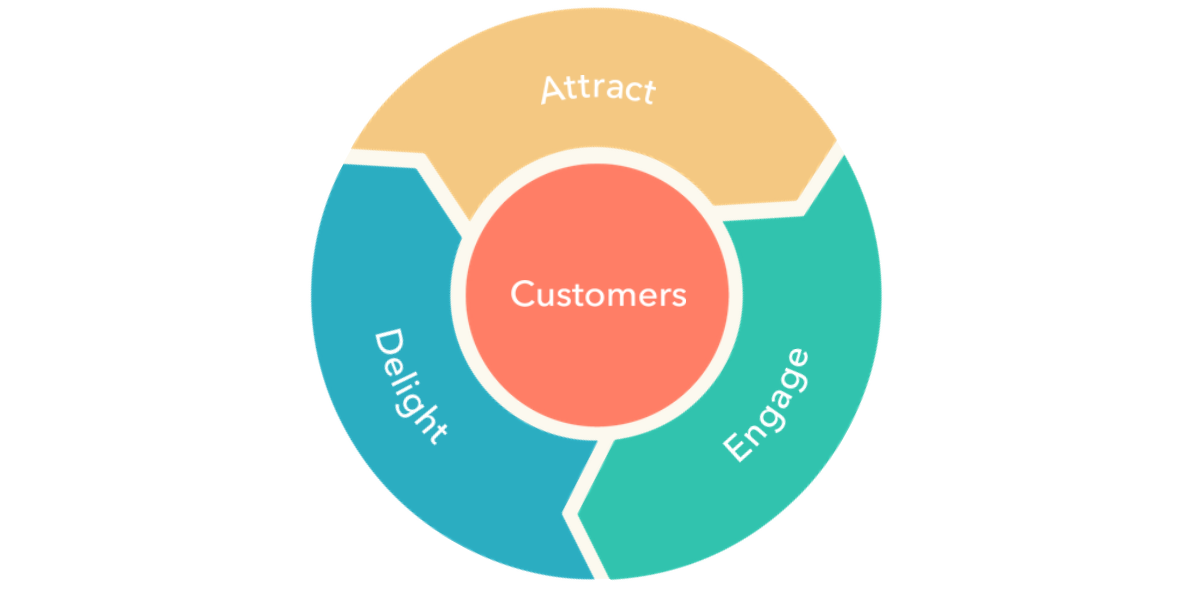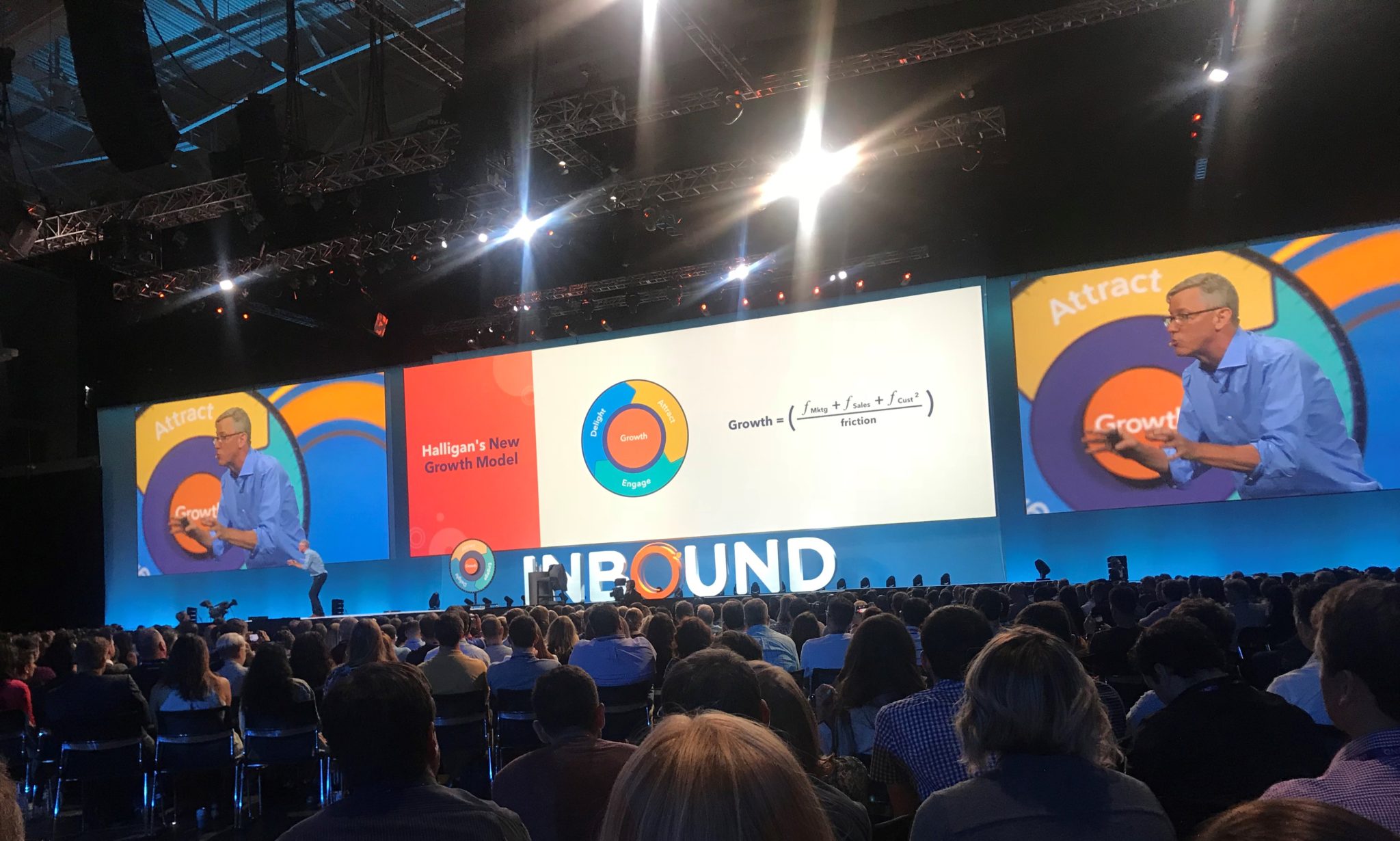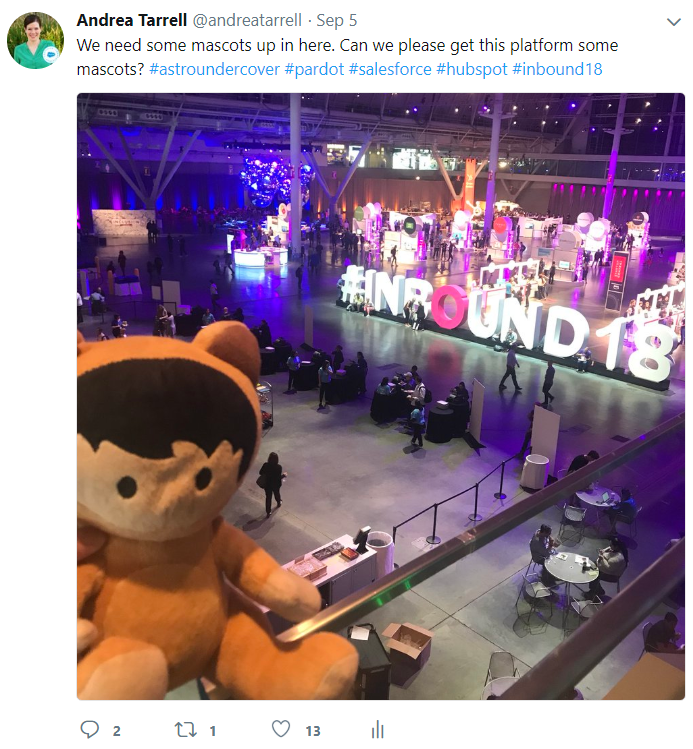Last year, I wrote a blog about why Pardot users should care about #INBOUND17. This year, I had the opportunity to attend the Hubspot’s annual conference in person. I even brought a buddy…
So why would a Pardot blogger pay attention to Hubspot?
First, I’d like to clarify that while this blog is the “Spot for Pardot,” my company is marketing automation platform agnostic. Our mission is to help marketers be successful on the Salesforce platform – whether that’s all-in Ohana or Salesforce + another marketing automation platform.
But regardless of business focus, I think it’s hugely valuable for martech pros to be in the know about what’s going on with other platforms.
Our space is evolving so rapidly and in such interesting ways. If you blink, you’re behind.
So if you’re interested in knowing what Hubspot is up to — read on.
Coming out of INBOUND 2018, a few themes really stuck with me:
1. Ding dong, the funnels are dead
Normally, any time a martech vendor declares something “dead,” I roll my eyes.
But when Brian Halligan took on funnels in his keynote, I couldn’t have agreed more.
If there’s a marketing idea that’s ready to die, it’s the concept of a funnel.
Funnels look great on paper. They’re easy to organize and color code. But they do not reflect how most humans make decisions or buy things.
The buyer’s journey is largely non-linear. A potential buyer is aware of your brand, then they forget. They’re in consideration stage, then they get distracted. They ask for a proposal, then go dark, then come back 6 months later. They buy… and then they come back and buy again later.
Knowing that this is the behavior we’re working with, marketers jobs’ are tougher than ever. Buyers are on a journey each their own, on their own terms. And they may have no desire at all to engage in traditional sales and marketing channels.
So the goal becomes how to meet prospects where they’re at, address their need in that particular moment, and build a consistent brand experience no matter how the buyer chooses to connect.
2. A new day is dawning… for the flywheel
So if we all go and burn our funnels, what rises from the ashes?
Between doses of insight and dad jokes (A+ paternal humor, truly), Halligan unveiled a new frame for the challenges marketers face. He calls it the Flywheel:

The middle seater next to me flying out of BOS read this over my shoulder, slammed her drink down, and yell-whispered:
“I’m not building a f*cking flywheel.”
Sorry random lady, I totally am.
The flywheel concept totally clicked with me. When buyers are on a non-linear journey, the key to marketing success is also non-linear.
When you’re first getting started with a new marketing initiative, it feels impossible and endless. You feel like you’re rolling a boulder up a hill — or to stick with this analogy, trying to move a massively heavy flywheel.
But each marketing and sales win builds momentum. A sale isn’t the end of the road — it’s one of many pushes that accumulate and makes things spin faster. Each success feeds into a virtuous cycle that begets further success.
3. Burn your marketing job descriptions
You might notice that many of the things on the flywheel don’t fit tidily in the “marketing” box.
The definition of what is considered marketing is rapidly expanding. And I think the marketing leaders of tomorrow will be the ones that embrace that.
Who better to own the end-to-end customer experience than marketing? Who else sits at the intersection of sales, service, and big picture brand strategy?
The flywheel is such a solid visual because it illustrates:
a) the role that customers can play in driving growth
b) how marketers are uniquely poised to touch the entire organization.
In the last 6 months, I’ve seen easily 10X requests for Pardot + Service Cloud than I’ve seen in my entire career as a consultant – and I think this is an offshoot of this phenomenon.
4. Campaign Influence Reporting is where it’s at
If ya’ll have been here for a hot minute, you know that I’m head-over-heels obsessed with Campaign Influence Reporting. I didn’t hear this as a theme mentioned at the conference (it’s not a HS core competency), but it was something I couldn’t stop thinking about nonetheless.
In the age of the flywheel — where every customer interaction is “marketing” – how do you actually measure what’s working? How do you track which marketing, sales, and service initiatives move the needle? How do you get visibility into what online and offline efforts touch a prospect on its way to becoming a closed won opportunity?
I pose a lot of rhetorical questions in my blogs, but these are not among them. There’s an answer – and it is campaign influence reporting.
Every single marketer with access to a Salesforce org should be tuned into this. Whether you’re using Pardot, Hubspot, or carrier pigeons to disperse your marketing message, this will have an impact on your ability to credibly demonstrate contribution to revenue.
[Want to chat “art of the possible” for your organization? Hit me up at [email protected]. I love talking about this.]
5. Friction is the enemy of growth
So you invest all of this energy in getting your flywheel humming. The biggest barrier to sustaining momentum is customer friction.
This quote from Dharmesh Shah struck a chord with me:
“You don’t need to make your product 10X better, you need to make your experience 10X lighter.”
Reducing customer friction isn’t a new or novel concept. But it’s still hyper relevant, because friction is all around us — even with some of the biggest and best loved brands.
A no-friction pre and post sales experience has the power to differentiate your business in a big way. And small businesses actually have an advantage here over the big dogs to mobilize and make a change.
Some food for thought on pre-sales friction: How can you simplify the choices your buyers face and accelerate the path to a “yes”? What parts of your sales process introduce hassle, tension, or uncertainty for the buyer? In what situations can technology (i.e. CPQ or electronic signature apps) help accelerate deal closure?
Post-sale, how do you continue to captivate your buyers, be easy to do business with, and create an experience that inspires loyalty/love?
6. Build your mini-empire with scalable materials
Another theme that emerged was that of “scalable materials” in the context of what we do.
Building a martech stack sometimes feels a little Game of Thrones. Each of our companies has limited resources. And you try to deploy them in a way that makes sense.
There’s a near term mission (e.g. escape the House of the Undying) — but you’re playing the long game too (e.g. vying for the Iron Throne) and you can’t lose sight of that.
When choosing a platform, of course make sure your needs are met today. And then picture what you might need when your business doubles, and doubles again. Find a platform that is accessible/usable/empowering for your team now, and ensure it leaves the door open to other functionality and tools that you will grow into.
For when you’re the Mother of Dragons, and all.
What do you think?
What vendors are you keeping an eye on? Who is contributing interesting insight on where our industry is headed? Did you pick up on anything from INBOUND 2018 that I missed?
Let me know in the comments, yo!












Pardot is a great Marketing Automation tool and I find HubSpot to be a great marketing platform. I implement both tools and like them both for different reasons as I find them to be very different tools. One thing that I wish Pardot would do is invest in its API’s Is so easy to extend the capabilities of HS while Pardot…not so much beyond a limited set of connectors.
My team has built some custom functionality using the current API. Word on the street is that a revamped API is a work in progress right now…